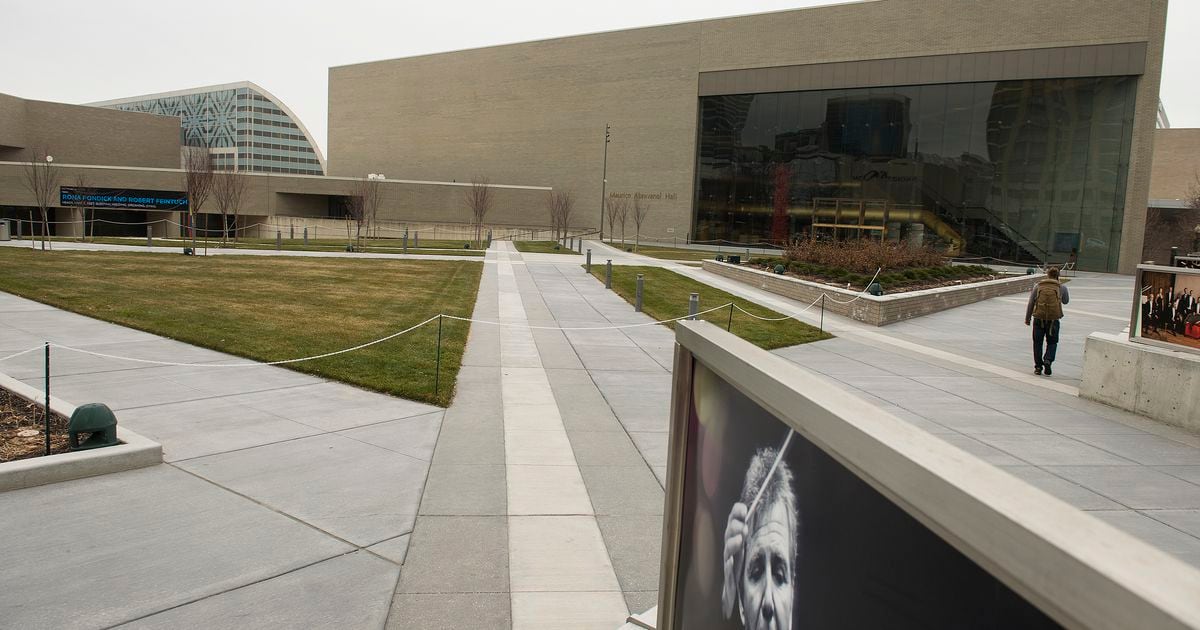Jack Clark is 18 years old, but already he has performed in Abravanel Hall — the downtown Salt Lake City home of the Utah Symphony — several times.
Clark, who lives in Layton, said he was in rehearsal with the Utah Youth Symphony, when Barbara Ann Scowcroft, one of the Utah Symphony’s violinists, talked to the student musicians about the potential fate of Abravanel Hall. Clark has played the viola for almost a decade.
“She told us [during] our break that there is a possibility of Abravanel Hall being torn down, and that kind of hit me hard,” Clark said.
The suggestion that the 45-year-old Abravanel Hall could be demolished or altered has been floated as Smith Entertainment Group — the company headed by billionaire Ryan Smith that owns the Utah Jazz and the state’s newly acquired National Hockey League franchise — begins planning for an “entertainment district” adjacent to the teams’ home at Delta Center.
No decisions have been made about any of the Smith group’s proposals. A spokesperson for Utah Symphony | Utah Opera confirmed that symphony leadership was planning to meet Monday with a representative of Smith’s group and Salt Lake County Mayor Jenny Wilson.
Clark said the news felt like a “kind of betrayal” to him. “It’s important to me that it’s preserved,” he said.
On Saturday afternoon, Clark posted an online petition, “Save Abravanel Hall,” on the website Change.org. It attracted more than 3,400 signatures within the first 24 hours. By Monday morning, more than 10,000 people had signed.
Clark described the response to his petition as “crazy.”
“A lot of this is a very emotional topic for some people, because both these forms of entertainment for me are just as valuable as one another,” Clark said, adding that he “thoroughly believes” that both entertainment forms — hockey and the symphony — can coexist. “We can have it both ways,” he said.
In the petition, Clark wrote that if Abravanel Hall was torn down, “the Utah Symphony would have no place to play, and the performing arts in Utah would come to a standstill — possibly ending the orchestra as we know it.”
(Trent Nelson | The Salt Lake Tribune) Thierry Fischer conducts a rehearsal of the Utah Symphony at Abravanel Hall in Salt Lake City on Thursday, May 25, 2023.
One of the city’s ‘cultural gems’
Amanda Eiting, 28, said she has been a fan of the Utah Symphony since she moved back to Salt Lake City in 2020 — and last year, she finally got a season pass. “This past year, I’ve been going to a lot of them,” she said, “and it’s really been such a bright spot for me.”
Abravanel Hall is one of the city’s “cultural gems,” Eiting said, and the possibility of the venue being destroyed makes her feel “sad and disappointed.”
Attending the symphony, she said, is something passed down in her extended family. Her husband, Jake, often went with his grandmother when he was a kid. Eiting said his grandmother has been taking her grandkids there for 20 years — and the Eitings “paid back the favor” by taking her to the symphony for her 89th birthday.
“I absolutely love that I can listen to a world-class symphony music on a Friday night and then go do a big hike, like from my door, all without a car,” Eiting said. “I can bike or take the public transportation down to Abravanel Hall, and then I can go do some world-class skiing or mountain biking or hiking in the very same weekend. Like, where else is that true?”
Clark said that, as a young person, “it’s important that we get the youth involved, because … we want to preserve this building which is, in some ways, part of the intangible cultural heritage of Utah.”
Clark said he wants people, particularly elected officials and the media, to pay attention and awareness to the “beautiful building.”
Abravanel Hall, he said, “is the center of performing arts in Utah. People’s livelihoods are at stake if it is torn down. Right now, I think we need to focus on bringing awareness to the issue because it’s up to the county to decide whether they demolish it or not. I also want Ryan Smith to know that we can both win: You can have your way and we can have our way, too.”
(Trent Nelson | The Salt Lake Tribune) Thierry Fischer conducts a rehearsal of the Utah Symphony at Abravanel Hall in Salt Lake City on Thursday, May 25, 2023.
A ‘most endangered’ historic building?
Salt Lake County owns and operates Abravanel Hall, the Utah Museum of Contemporary Art and the Salt Palace Convention Center — which share the two-block stretch of West Temple that is at the heart of the Smith group’s plans.
Wilson, in a statement, acknowledged that “Salt Lake County is in the early stage of conversations and planning around the future of the blocks surrounding the Delta Center. … With a goal of a convention, sports, entertainment and cultural district downtown, we are thoughtfully evaluating how the development may shape downtown and how the Salt Palace, UMOCA and Abravanel Hall fit into this equation.”
After news broke of the Smith group’s plans, the nonprofit Preservation Utah, which advocates to protect historic spaces, declared Abravanel Hall one of the 14 most endangered buildings and places in Utah.
The hall’s “fate hangs in uncertainty, lacking protected status, sparking concerns about the county’s commitment to preserving this iconic structure,” the group wrote on its website.
Steven Brosvik, president and CEO of Utah Symphony | Utah Opera, issued a statement last week that said Abravanel Hall “has a remarkable legacy and holds deep meaning for so many in our community,” while also acknowledging that “the downtown redevelopment project presents an extremely exciting opportunity for Salt Lake City.”
Elected leaders, Brosvik said in the statement, “have all expressed their support for and recognition of the value of the arts in Utah, as well as their commitment to ensuring that an outstanding hall for the Utah Symphony is a top priority.” Brosvik specifically mentioned Wilson, Salt Lake City Mayor Erin Mendenhall and Gov. Spencer Cox.
Besides being the Utah Symphony’s home, Abravanel Hall has also been the location for concerts for everyone from Celtic Woman to Dave Chappelle, hosted countless high school graduation ceremonies, held a 2001 interfaith service led by the Dalai Lama, and from 1997 to 2003 was the site of the opening-night gala for the Sundance Film Festival.
Adam Lambert, principal of Judge Memorial Catholic High School, said in a statement that “over the last few decades, we’ve been fortunate to be welcomed into Abravanel Hall and have always appreciated their incredible hospitality.”
(Laura Seitz, pool | AP photo/Deseret News) His Holiness the Fourteenth Dalai Lama exits the stage with the Right Rev. Carolyn Tanner Irish, Episcopal bishop of Utah, at an Interfaith Service at Abravanel Hall in Salt Lake City, Utah, on May 11, 2001.
The maestro and the hall
Abravanel Hall opened to the public on Sept. 14, 1979, though it had been envisioned by its namesake — the Utah Symphony’s legendary conductor and musical director, Maurice Abravanel — a decade earlier, The Tribune reported in 2019 on the hall’s 40th anniversary.
Plans for the Salt Palace, built in 1969, included a concert hall just to the north. But when construction bids came in about $4 million higher than architects’ estimates, Obert C. Tanner — the jewelry magnate who sat on the symphony’s board and chaired the commission charged with building the hall — “reluctantly” agreed to stop the building proposal, “reserving our plans to use the location … when funds might be available,” he wrote.
Abravanel, his biographer Leon Durham wrote in 1989, was “beside himself,” declaring, “my board has betrayed me!”
In 1972, Gov. Calvin Rampton proposed building a symphony hall, to celebrate the U.S. bicentennial in 1976. Voters approved a bond in 1975 to pay for it. The price tag, ultimately, came to $12 million — the equivalent of nearly $52 million today.
Abravanel made a pitch to the construction committee chairman — Jack Gallivan, then the publisher of The Salt Lake Tribune — on who should design it: Cyril Harris, an acoustician and professor at Columbia University, who was known for creating the sound design of such concert halls as the Metropolitan Opera in New York and the Kennedy Center in Washington, D.C.
(Tribune file photo) Long-Time Utah Symphony conductor Maurice Abravanel with his successor, Varoujan Kodjian, in November 1979.
As Abravanel put it, “Symphony Hall is the only one in the world where, instead of first hiring an architect and telling him to consult an acoustician, it was the other way around.”
The lead architect, Franklin T. Ferguson of FFKR Architects, said he was inspired to create the hall’s glass facade when he drove to the site when it was still a parking lot, and looked across the street — and saw the shining dome of the Salt Lake Tabernacle, which had been the symphony’s home since 1946.
Abravanel himself never conducted in the hall. He had open-heart surgery in 1976, and retired in April 1979, “on the advice of my doctor,” he said. He turned down requests to return to the podium after the hall opened that September.
Symphony Hall was renamed Maurice Abravanel Hall in May 1993. The maestro died five months later, on September 22, at age 90. His public viewing was held in the lobby, and the funeral took place in the hall.
The hall has seen renovations over the years — most recently in 2017, when a new escalator and carpeting were installed. The most significant change to the hall came in 2001, with the addition of a 27-foot-tall glass sculpture by artist Dale Chihuly, “Olympic Tower” — 1,276 pieces of hand-blown glass in red, orange and yellow, symbolizing the Olympic flame.
The tower was meant to be a loaner for the 2002 Winter Olympics. After the games, private donors and the Salt Lake Olympic Organizing Committee paid for the sculpture to be bought for $625,000. It was valued at $900,000, but Chihuly gave a discount. Chihuly had two conditions, though: The work must be visible to all (which the glass facade allowed) and it must stay in Abravanel Hall, never to be moved.
(Francisco Kjolseth | Tribune file photo) The main entrance to Abravanel Hall in August 2017, with glass artist Dale Chihuly’s sculpture “Olympic Tower” prominent in the lobby.
Editor’s note • This story is available to Salt Lake Tribune subscribers only. Thank you for supporting local journalism.









